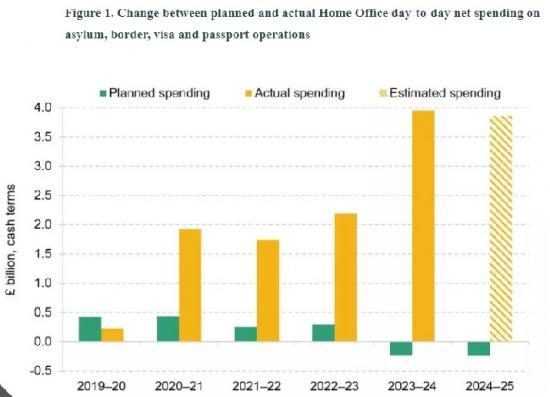Home Office Budgeting And Asylum Overspends - Part Of The Black Hole
2nd September 2024

The Institute for fiscal Studies takes a look at the latest shock n spending for immigrants and its a big shock.
The Home Office has repeatedly spent far more than budgeted for asylum, border, visa and passport operations in recent years.
Rachel Reeves's recent audit of public spending identified a range of in-year spending pressures facing the new government. One of the largest pressures was for costs relating to asylum and illegal migration, with an estimated £6.4 billion of pressures on day-to-day spending in 2024-25. A key plank of the new Chancellor's argument was that these costs were genuinely unexpected and could not be met from within the departmental budgets she inherited from her predecessor. In response, Jeremy Hunt argued that civil servants had signed off the Home Office budget (its ‘Main Estimates' in the jargon) just weeks earlier and suggested that these Main Estimates contradicted the figures presented by Ms Reeves.
In this comment, we explain this seeming contradiction and document the deeply unsatisfactory way that the Home Office and HM Treasury have budgeted for asylum costs in recent years.
The crux is that between 2021-22 and 2023-24, the Home Office planned at the start of each year to spend an average of £110 million on asylum, border, visa and passport operations (the relevant spending category). But spending turned out much higher: an average of £2.6 billion per year. It was clear that the amounts being budgeted were insufficient - the Home Office acknowledged as much. But every year, the Home Office would submit unrealistically low Main Estimates, and the Treasury would top them up later in the year (at the ‘Supplementary Estimates') from the Reserve (a contingency fund supposedly set aside for ‘unforeseen, unaffordable and unavoidable' spending items).
The problem for the new government is that it inherited a position where asylum costs this year appear to be on a similar scale to those seen in previous years, but the Reserve has already been spent elsewhere. This was to some degree predictable but is no less of a fiscal headache for that. We conclude with some thoughts on what this means for the spending framework.
How has spending differed from plans in recent years?
Figure 1 shows how much the Home Office planned to spend on asylum, border, visa and passport operations at the start of the financial year (its ‘Main Estimates’) and the final budget it was allocated towards the end of the financial year (its ‘Supplementary Estimates’) for each of the last six years. This approximates the amount the Home Office was budgeting at the start of the year, and the amount it ended up spending at the end of the year. The Home Office raises money from visa and passport fees, and so this shows net rather than gross spending (i.e. the net amount spent after taking account of income from fees) - in other words, the amount of funding the Home Office needs from the Treasury. Last year and this year, this amount was estimated to be negative (i.e. the Home Office expected its income from fees to exceed its spending).
Read the full report HERE
